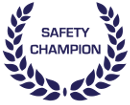Differences in learning styles, attention spans and the way that we generally consume information these days, means that the way we train must evolve to keep it relevant and suit changing needs.That’s why when we stumbled across the old 70:20:10 learning model in our research, we thought it was worth a blog.
Whilst this model has been around for a little while, we feel that it is still incredibly valid! Especially for those people responsible for training staff in health and safety. Understanding the 70:20:10 model might actually help you ensure that your training and onboarding is relevant, whilst also assisting your managers and supervisors to build better rapport with their team members. And all of this leads to your people actually engaging with your health and safety training, rather than your health and safety training just serving as a ‘tick the box’ exercise.
The idea is this;
70% of everything you learn comes from your own personal on-the-job or general life experiences
20% of everything you learn comes from your interaction with others – feedback or observations
10% of everything you learn comes from formal training and courses
As you can see, this model indicates that while formal training sessions and course work is certainly a part of our learning, it is only a very small part of the larger piece. As health and safety professionals, this is particularly interesting – because we see businesses still placing considerable emphasis on getting their people into a room and training them in operational activities – so those boxes are ticked – rather than buddying them up with more experienced operators, or identifying innovative ways that they can build capability of their people in the field.
Don’t get us wrong, we believe formal health and safety training sessions are hugely important. However, we shouldn’t be stopping there when it comes to making sure our workers are fully briefed, ready to properly handle hazards and mitigate risks to ensure that they keep themselves and others safe in the workplace.
So, to get your workers to more thoroughly understand and adopt relevant health and safety skills and knowledge, try facilitating better on-the-job learning opportunities for ‘peer learning’. A couple of ideas could be;
- Hold quick daily or weekly meetings to reflect on recent work to find any risks or hazards so you can learn from them.
- Encourage older staff to take an active role in training the younger ones, even if they don’t think it’s their job.
- Remind the younger and new staff to constantly seek advice and guidance from the others before proceeding with anything.
- Encourage older and more experienced staff to share relevant health and safety stories and experiences they’ve had in yours and other workplaces.
- See if you can build on the social aspects in your workplace. Allow workers to implicitly learn through informal and unstructured conversations.
Clearly there are many things you can do – but it’s all about communication, observation and experience. So, try encouraging or facilitating more opportunities for people to learn in a variety of ways, and you’ll see vast improvements in the uptake of your health and safety practices and procedures!




